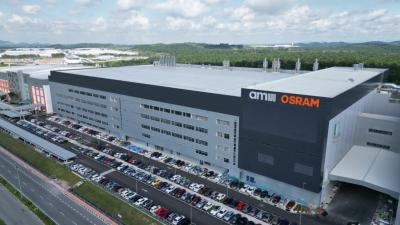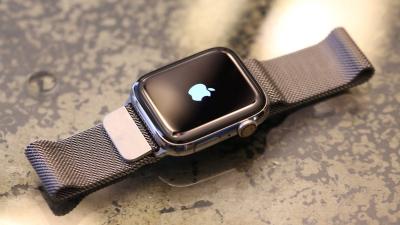 Apple, one of the world's largest companies, develops consumer electronics and computer software, and the company also develops a wide range of next generation technologies.
Apple, one of the world's largest companies, develops consumer electronics and computer software, and the company also develops a wide range of next generation technologies.
In 2014 Apple acquired MicroLED display developer LuxVue Technology. LuxVue raised $43 million in funding prior to the Apple purchase. Since the LuxVue acquisition, Apple accelerated its MicroLED R&D project and developed solutions for smartwatches, AR and other display types. Apple established a dedicated microLED research and production facility in Taoyuan, Taiwan, and according to reports, Apple invested over $3 billion on microLED R&D. In early 2024, Apple decided to cancel its MicroLED smartwatch display project, and it's current microLED plans are unknown.
Apple microLED Watch
Apple developed MicroLED technologies for many years , and its first goal was to adopt microLED displays in smart watch devices. The latest Watch devices use LTPO OLED displays, but a microLED display could enable Apple to extend the Watch battery life and increase its brightness. As we said, the project was cancelled in early 2024, but it is likely that if display developers commercialize microLEDs, Apple could adopt these for future watch devices.
1 Infinite Loop
Cupertino, CA 95014
United States
ams Osram announces its new microLED strategy, will mostly withdraw from the microLED display market
In February 2024, ams-Osram announced that it's cornerstone customer (Apple) cancelled its microLED project, which will have dire implications for Osram's own $850 million 8-inch microLED epiwafer factory in Malaysia. Back then ams-Osram estimated that it will have impairment charges of $650 to $900 million and it will also likely to cancel or delay some of its investments in Malaysia.
ams-Osram now announced its plans and strategy following Apple's decision to cancel its project. It seems as if the company has decided to pretty much withdraw from the microLED display market, and the only remaining microLED development efforts will focus on automotive lighting products. ams-Osram now believes that microLED displays will primarily play a role in several smaller applications that also will scale slower and later than previously expected. We also believe that microLED displays will take a longer time to mature than some in the industry have expected.
KLA withdraws out of the display inspection market, another casualty of Apple's microLED decision
Last month Apple decided to cancel its microLED Watch project, which had very bad consequences for many microLED developers. Ams-Osram is still considering its options and it estimates its loss at $650-900 million, while Singapore-based electronics assembly solutions provider Kulicke & Soffa announced that it was also effected, to the tune of $110-130 million as it cancelled its own project with Apple.
KLA Corporation recently announced that it is withdrawing from the FPD market altogether. The company entered this market when it bought Israeli Orbotech for $3.4 billion, developer of inspection equipment for the semiconductor and display industries.
Samsung plans to release its first microLED wearable display in 2025, but this may get delayed
In early 2023, it was reported in Korea that Samsung Display started a new project to develop microLED wearable displays, aiming to finish the development by the end of 2023, and supply it to Tier-1 wearable makers such as Apple or Samsung Electronics.

According to a new report, Samsung Electronic had indeed started developing a microLED powered Galaxy Watch device, aiming to release it in 2025. Following Apple's microLED wearble project cancellation, Samsung is also now debating whether to cancel or delay its own microLED smartwatch project.
Kulicke & Soffa cancels its microLED Project W, expects $110 million in charges
Following Apple's cancellation of its microLED Watch project, Singapore-based electronics assembly solutions provider Kulicke & Soffa announced that its own so-called Project W (probably referring to the Watch) is cancelled, following a project cancellation by a strategic customer, likely to be Apple.
K&S says it expects charges, including impairments, in the range of $110-$130 million, most of it due to inventory write-downs and impairment charges relating to long-lived assets.
Tianma and Konka to continue their microLED projects despite Apple's withdrawal
A few days ago, Apple decided to cancel its microLED project with ams-Osram, a development that took the display industry by surprise (or at least parts of the industry). MicroLED developers are now looking to understand how Apple's decision will shape the industry, and a couple of days ago two China-based developers, Tianma Microelectronics and Konka, said that they are continuing their own microLED developments projects, as the companies are still optimistic about the future of microLEDs.
Konka has vertically integrated its supply chain and is producing its own microLED chips using Aixtron's MOCVD systems. Back in 2019, Konka announced it is building a $365 million micro-LED R&D center in Chongqing, as the company believes that Micro-LED will become the leading technology for ultra-high quality consumer TVs. Earlier that year, Konka launched tiled large micro-LED displays called APHAEA brand. Konka demonstrated several possible configurations - including 118" 4K and 236" 8K. The price of a 118" 4K display was around $240,000 while the 236" 8K TV had a price tag of $1.25 million. Click here for more information on Konka's APHAEA micro-LED TVs.
How will Apple's withdrawal impact the MicroLED industry?
A few days ago, Apple decided to cancel its microLED project with ams-Osram, a development that took the display industry by surprise. It certainly surprised ams-Osram, which announced it will have to re-assess its microLED strategy and incur $650-900 million in impairment charges. It is currently unclear whether Apple's decision was to completely abandon microLED technologies, or if it still in the microLED race, perhaps with different technologies and suppliers. It is likely that Apple does not have any immediate plans to introduce microLED displays, though. In this article, we'll try to analyze the reasons which led to Apple's decision and the probable implications for the microLED industry.
Summary:
- Apple cancels its microLED project with ams-Osram
- We estimate that the main reasons are Apple's technology choice and strategy
- MicroLED production will require next-gen technologies to succeed
- MicroLEDs still pose the best route for the future display technology, but companies will need to realign their strategies
Apple worked on microLED R&D since 2014, with a first target of producing microLED smart watch displays to replace the currently-used AMOLED displays. The Company had several partners, and decided to handle some of the process in-house. It seems as if even after almost 10 years of development and intensive R&D (estimates of Apple's total investment in microLED technology so far range between $1-3 billion USD), the technology was not ready for mass production - at least not at a price that Apple can accept.
Apple cancels its microLED wearable display project, how will this affect the microLED industry?
Apple started developing microLED displays for wearable devices years ago, first aiming to launch the first product in 2023. The project was delayed several times, as the cost of production for microLED displays was too high for Apple, to the point where it was suggested Apple's goal is to launch the first microLED watch in 2027.
One of Apple's main microLED partners is ams-Osram, that is building a $850 Million 8-inch microLED epiwafer factory in Malaysia. Yesterday ams-Osram announced that its "cornerstone project" (it did not name Apple specifically) got unexpectedly cancelled. This triggered ams-Osram to re-assess its microLED strategy. As a first estimate ams-Osram believes it will have impairment charges of $650-$900 million and it will also likely to cancel or delay some of its investments in Malaysia (which may actually improve the company's cashflow in the next two years).
Reports from Korea suggest that Apple may further delay its first microLED watch to 2027
Apple started developing microLED displays for wearable devices years ago, first aiming to launch the first product in 2023. The project was delayed several times, as the cost of production for microLED displays is still too high for Apple.
Last year TrendForce estimated that Apple will not be able to introduce its first microLED watch until 2026 - and now we hear some new reports that suggest that this won't happen until 2027 at the earliest.
TrendForce: Apple delays the launch of its microLED smartwatch further to 2026
Apple has been developing microLED displays for wearable devices for many years, but the company and its production partners are not yet ready to initiate mass production. It was reported before that the company planned to launch the first microLED-powered watch in 2023, but this was delayed several times.
According to a new report by TrendForce, Apple delayed its microLED plans again, now hoping to introduce the first device in 2026. The main problem, as always, is the high production costs.
A new report by Nikkei Asia details Apple's microLED production plans
Apple's microLED projects and goals have been reported and rumored many times in the past, and now the respected Nikkei Asia newspaper posted an interesting article with new details of Apple's microLED plans. Some parts of this plan were already published by other reporters, note.

According to the new report, Apple is aiming to get more involved in display manufacturing, to increase its control over its supply chain, and reduce its reliance on Samsung Display specifically. Apple has decided, therefore, to handle the LED transfer (pick-and-place) process by itself, at its R&D facilities in Longtan, Taoyuan, Taiwan.
Pagination
- Page 1
- Next page









